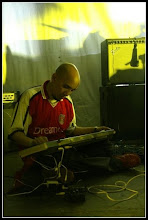
East Village Eye cover featuring James Chance
In many ways, No Wave is not a clearly definable musical genre with consistent features. Various groups drew on such disparate styles as funk, jazz, blues, punk rock, avant garde, and experimental. There are, however, some elements common to most No Wave music, such as abrasive atonal sounds, repetitive driving rhythms, and a tendency to emphasize musical texture over melody—typical of the early downtown music of La Monte Young. No Wave lyrics often focused on nihilism and confrontation.

No Wave poster for film by Amos Poe
No Wave is often better defined in terms of the artistic environment in which it thrived (the downtown scene of minimalist art) and the character of performances typical to its context. No Wave performances drew heavily on performance art and as a result were often examples of a highly theatrical minimalism in their renditions.
In 1978 a series of punk rock influenced loud noise music was held at New York’s Artists’ Space that led to the Brian Eno-produced recording No New York. This recording was the first attempt to define the no wave sound, documenting The Contortions, Teenage Jesus & the Jerks, Mars and DNA.
The Noise Fest was an influential festival of art noise music curated by Thurston Moore of Sonic Youth at the art space White Columns in June 1981. Sonic Youth made their first live appearance at this show. Each night three to five acts performed, including Glenn Branca, Rhys Chatham, Jeffrey Lohn, Dog Eat Dog, Built on Guilt, Rudolph Grey, the Avant Squares, Mofungo, Red Decade, Robin Crutchfield's Dark Day, Ad Hoc Rock, Smoking Section, Chinese Puzzle, Avoidance Behaviour, and Sonic Youth.
No Wave had a notable influence on noise and industrial bands who formed after, like Big Black, Lev Six, Helmet, and Live Skull. The Theoretical Girls heavily influenced early Sonic Youth, who then emerged from this scene by creating music that eventually reached mass audiences and critical acclaim. Also for new bands like Liars, Ex Models, Neptune, and Erase Errata the influence of the No Wave scene was important.
Simon Reynolds, author of Rip It Up and Start Again: Postpunk 1978-1984, wrote:
And although "affection" is possibly an odd word to use in reference to a bunch of nihilists, I do feel fond of the No Wave people. James Chance's music actually stands up really well, I think; there are great moments throughout Lydia Lunch's long discography, and Suicide's records are just beautiful.
No Wave music inspired the Speed Trials noise rock series organized by Live Skull members in May 1983 at White Columns with the music of The Fall, Beastie Boys, Sonic Youth, Lydia Lunch, Elliot Sharp, Swans and Arto Lindsay. This was followed by the after-hours Speed Club that was fleetingly established at ABC No Rio.
